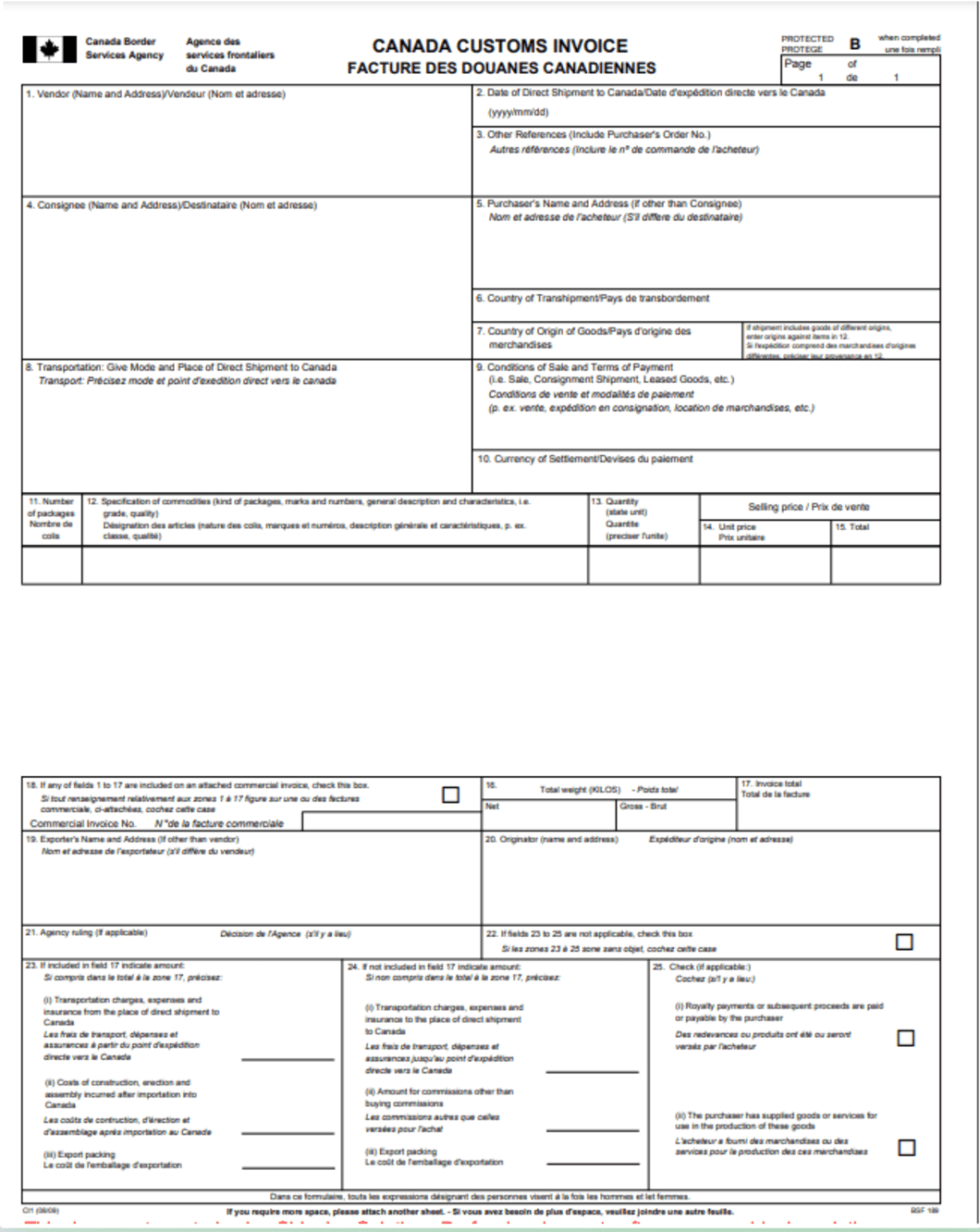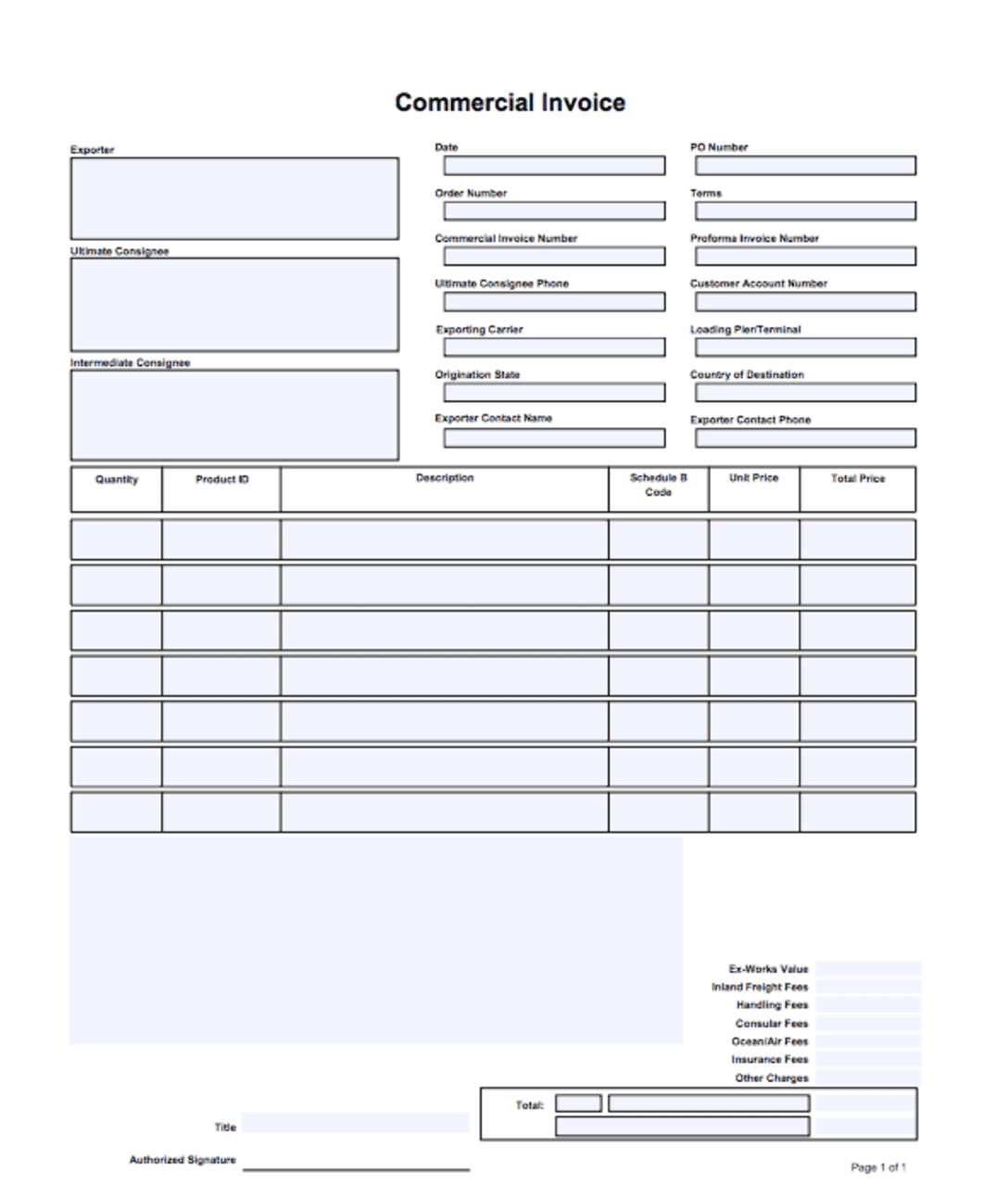Export Invoice: All you need to know

Exporting goods or services involves a fair amount of paperwork. One document you must get right is the export invoice – the primary bill for an international sale.
In simple terms, an export invoice is the legal document and proof of sale that details what you sold, who you sold it to, the price, and the terms of the deal.
It’s similar to a regular sales invoice but is specifically used for cross-border transactions, containing extra information needed for customs and compliance (like your Import-Export Code (IEC), foreign currency details, etc.)
In this guide, we’ll explain what an export invoice is, why it’s so important, when and how to issue one, the different types of export invoices, what information it should include, and best practices for formatting. We’ll also address common questions and provide a sample export invoice format for reference. Let’s dive in!
What is an Export Invoice?
An export invoice is a detailed bill or document issued by the exporter (seller) to the foreign buyer for an international sale. It itemises the goods or services sold, their quantities and prices, the buyer and seller details, and the agreed payment terms.
In essence, it serves as a contract and proof of transaction between the exporter and importer. Unlike a domestic GST invoice, an export invoice includes additional information required for global trade – such as the buyer’s overseas address, currency of transaction, relevant trade codes (HS codes), and declarations for customs.
This document is critical for the export process. It is used by customs authorities in both the exporting and importing countries to verify the shipment details, assess the value of goods, and calculate duties or taxes.
An export invoice is typically based on a commercial invoice format, meaning it contains all the details of a standard sales invoice plus any export-specific requirements.
How is an export invoice different from a regular invoice?
For one, an export invoice is meant only for international transactions. It usually needs extra details like the IEC number, the country of origin of goods, applicable Incoterms, and a declaration if it’s a zero-rated (tax-free) export under GST.
A regular domestic invoice (or “accounting invoice”) just covers local tax requirements, whereas an export invoice covers both the commercial sale info and logistical details (like shipping and regulatory information) needed for cross-border trade
What is the Importance of Export Invoices in India?
An export invoice plays many roles in India as follows:
Legal proof of export transactions: An export invoice is a legal document verifying a sale between an Indian exporter and a foreign buyer. It also serves as a legal proof in the case of any dispute
Customs clearance: As the export invoice includes details like quantity, rate, size, and volume, customs authorities use it to calculate taxes before handling the final clearance. Without an export invoice, it’s challenging for them to calculate tax, thereby stopping your products from export
Facilitation of payments: The payment terms and conditions are mentioned in an export invoice. So when the export invoice is made both parties adhere to those terms for a streamlined payment experience
Claiming export benefits: An Indian exporter can use the export invoice to claim rebates, tax credits, and incentives from the government. For example, The Remission of Duties and Taxes on Exported Products (RoDTEP) scheme provides a rebate to exporters on central, state, and local taxes
Compliance with international trade laws: By sharing an export invoice, an exporter complies with international trade laws like the World Trade Organisation (WTO) agreements. Due to this they enjoy a good reputation and avoid facing legal issues.
When Should You Raise an Export Invoice?
Timing is critical when issuing export invoices, and it often depends on the nature of what you’re exporting (goods vs. services). In India, the GST law (Section 31 of CGST Act, 2017) provides clear rules on the time limit for raising invoices for exports
Timing is critical when issuing export invoices, and it often depends on the nature of what you’re exporting (goods vs. services). In India, the GST law (Section 31 of CGST Act, 2017) provides clear rules on the time limit for raising invoices for exports.
- Export of Goods: You must issue the export invoice on or before the time you dispatch the goods from your premises for export.amazon.in. In practice, this means the invoice should be ready by the time the goods are loaded for shipping (whether by air, sea, or land). Essentially, before the goods leave the country, the invoice should accompany them.
- Export of Services: If you’re exporting services, you can issue the invoice before providing the service, or within a specified period after service completion. Currently, that period is often interpreted as up to 30 days (some guidelines allow up to 60 days) after completing the service. For example, if you delivered a consulting project to an overseas client, you should invoice them within a month or so of finishing the work (sooner is always better).
- Goods Sent on Approval Basis: Some exporters ship goods on a sale or return (approval) basis. In such cases, where the buyer’s confirmation is pending, the law allows a bit more flexibility. You must issue the invoice when the buyer formally approves the purchase. If no approval (nor rejection) is received within 6 months of shipment, then an invoice must be issued at the 6-month mark from the date of dispatch. In other words, six months is the maximum time you can wait to invoice if goods were sent on trial/consignment.
These rules ensure that export sales are documented in a timely manner for tax and compliance purposes. Bottom line: always prepare the export invoice before shipping goods, and don’t delay invoicing for services beyond the allowed window. Late or missing invoices can lead to compliance issues or delays in getting paid.
Types of Export Invoices
When we talk about export invoices, it’s actually an umbrella term – there are a few different invoice types and related documents you might encounter in the export process. Below are the common types of export invoices and related documents, each serving a unique purpose:
- Commercial Invoice: This is the primary export invoice used in most export transactions. It’s the final bill of sale from the exporter to the importer, listing all key details: goods description, quantities, unit prices, total value, buyer and seller info, delivery terms, etc. The commercial invoice is the document customs authorities worldwide look at for valuing shipments and assessing dutiessThere’s no fixed format by law, but it must contain all the essential information about the sale. In essence, every export shipment will have a commercial invoice, making it the most important export document.
- Proforma Invoice: A proforma invoice is like a quote given before a sale is finalised. Exporters issue a proforma invoice to the buyer before shipping – often at the order or negotiation stages. It outlines the expected price, goods, and terms of the deal so the buyer can arrange import permits, open a letter of credit, or simply confirm everything before proceeding. Note: A proforma invoice is not a demand for payment; it’s a commitment on price/terms, to be followed by the commercial invoice once the goods or services are delivered.
- Customs Invoice: Some countries require a specialised customs-specific invoice form. A customs invoice contains similar info as a commercial invoice but might include extra details like the origin of the goods, tariff codes, freight and insurance costs, etc., as required by the importing country’s customs. Often, the importer (or their customs broker) will provide the exporter with a blank customs invoice form to fill out. The goal is to ensure customs in the destination country have all info needed in their preferred format to calculate duties.
- Consular Invoice: A consular invoice is required by certain countries (historically some in Latin America, Africa, Middle East) to authenticate the export’s details. It’s basically a commercial invoice that has to be certified by the consulate of the destination country in the exporter’s country. You usually obtain a special invoice form from the destination country’s consulate, fill it out, and get it stamped by the consulate (often with a fee). This process helps the importing country ensure the invoice is legitimate, the value is correct, and all is in order for customs.
- Legalised Invoice: A legalised invoice is similar to a consular invoice in purpose – it also requires official stamping – but is a bit more flexible in format. Instead of a pre-specified form, you prepare a normal commercial invoice and then have it attested (legalised) by the destination country’s embassy/consulate. Such invoices are commonly asked for in certain Middle Eastern countries. The legalisation confirms the document’s authenticity for foreign customs.
- Tax Invoice for Export (GST Invoice): In addition to the export (commercial) invoice, Indian exporters must also generate a GST-compliant tax invoice (if they are GST registered) for the sale, even if IGST is not actually paid on the export. This invoice might look identical to the commercial invoice, but includes your GSTIN and notes the tax treatment (explained below). It’s used for domestic record and to claim Input Tax Credit on inputs. Essentially, for GST purposes, an export is documented via a tax invoice that either charges IGST (to be refunded) or is marked “Export under LUT/Bond – IGST not payable.”
- Packing List: Often included with export documents is a packing list, which isn’t an invoice requesting payment but a detailed list of the shipment contents. It itemises each package/carton, what’s inside, dimensions, weight, etc.The packing list helps the importer and customs verify the shipment. Some exporters combine the commercial invoice and packing details, but it’s ideal to have a separate packing list document.
- Freight Invoice: If you hire a freight forwarder or shipping company, they will issue you a freight invoice (or transport invoice) for the shipping costs. This is separate from the commercial invoice you send to your buyer. The freight invoice comes from the logistics provider to you (the exporter), detailing charges like ocean/air freight, handling, insurance, etc. It’s important for your cost accounting and sometimes for customs valuation (certain countries require adding freight costs to the goods’ value for duty calculation).
 <div>A sample Customs Invoice</div><div><br></div>
<div>A sample Customs Invoice</div><div><br></div>As an exporter, you’ll at minimum be dealing with the commercial invoice (your export invoice proper). Depending on the destination and nature of goods, you might also encounter some of the specialised invoices above (consular/legalised or customs invoices), and you will definitely produce supporting documents like packing lists. Always check the import requirements of your buyer’s country to know if any special invoice format or attestation is needed. For example, a buyer in Egypt might inform you that a consular invoice (and perhaps a certificate of origin) is mandatory for their customs.
As an exporter, you’ll at minimum be dealing with the commercial invoice (your export invoice proper). Depending on the destination and nature of goods, you might also encounter some of the specialised invoices above (consular/legalised or customs invoices), and you will definitely produce supporting documents like packing lists. Always check the import requirements of your buyer’s country to know if any special invoice format or attestation is needed. For example, a buyer in Egypt might inform you that a consular invoice (and perhaps a certificate of origin) is mandatory for their customs.
Key Contents of an Export Invoice
No matter the type, every export invoice needs to include certain key information so that it’s legally valid, compliant, and useful for all parties. Here’s a comprehensive list of the contents and fields an export invoice should have:
- Exporter Details: The seller’s full name (or company name) and address, plus contact information (phone, email). If you’re an Indian exporter, include your GSTIN (Goods & Services Tax Identification Number) as well as your IEC (Import Export Code) on the invoice. These IDs help authorities identify you.
- Invoice Reference: A unique Invoice Number and the Invoice Date of issue. Invoice numbers should be sequential and unique (for your record-keeping and compliance). Optionally, you can also mention a Purchase Order number or reference number if it corresponds to the buyer’s order.
- Buyer Details (Consignee): The foreign buyer’s name (or company), address, and contact info. Often, the invoice will also name the consignee (the party to whom goods are delivered) and sometimes a notify party, if different from the buyer. Having the correct consignee address is crucial for customs.
- Description of Goods/Services: A clear breakdown of what you’re selling. For goods, include the product names, model or HSN/Harmonized System codes, quantities, unit prices, and total price per line item. You might also include each item’s gross weight or dimensions if relevant. It’s good practice to mention the country of origin of each product (many countries require origin on commercial invoices). For services, describe the service provided, the period it covers (if applicable), and the charge for it. This section should be detailed enough for customs to understand exactly what is being exported.
- Value and Currency Details: The currency of the invoice (USD, EUR, INR, etc.) and the breakdown of values. For each line, you have an amount, and then the subtotal/total invoice value. If you quoted on certain terms like FOB or CIF, you might show the FOB value and then add freight or insurance to arrive at the CIF value. Clearly state the total amount due on the invoice. If the invoice currency is not your local currency, you can mention the exchange rate for reference (or if required by regulations) For instance, an invoice in USD may note the conversion rate to INR for GST records.
- Terms of Sale & Incoterms: Include the Incoterm you agreed with the buyer (e.g. EXW, FOB, CIF, CFR, DAP, etc.) along with any specifics like “FOB Mumbai” or “CIF Hamburg”. This defines who pays for freight, insurance, and when risk passes. Also, mention the payment terms – e.g. “100% advance via T/T,” or “Net 30 days after BL date,” or “Letter of Credit at sight,” etc. These terms are usually negotiated beforehand, but must be stated on the invoice as the official agreement.
- Bank Details for Payment: It’s wise to provide your bank account details on the invoice so the buyer knows where to remit payment. Include the bank name, account number, SWIFT/BIC code, and beneficiary name. This is especially important if payment is via wire transfer. (For letter of credit transactions, bank details are handled in the LC itself, but it doesn’t hurt to have them on the invoice too.)
- Shipment Details: Reference any shipping-related info: mode of transport (air, sea, road, courier), and if applicable, the shipping route. You can mention the Port of Loading and Port of Discharge/Destination for clarity. If you have it, include the Shipping Bill number (for Indian exports, the shipping bill is the customs export document) or any export declaration number. You might also note the expected dispatch date or the container number if containerised. Essentially, tie the invoice to the shipment.
- Tax and Export Declarations: If your export is eligible for tax exemption (which is common), include a note or declaration regarding GST/IGST. For example, when exporting under a Letter of Undertaking (LUT) without paying IGST, you should add a line like “Supply meant for export under LUT – Payment of IGST not applicable”. Conversely, if you did charge IGST on the invoice (export with tax), state the tax amount and something like “IGST @0% – export of goods, tax to be claimed as refund”. The invoice should also display your GST tax rate and number if any tax is levied. In short, make it clear whether GST is charged or not, and why. Many exporters use phrases as guided by GST rules, e.g., “Zero-rated supply under bond/ LUT” or “Export with IGST paid (to be claimed as refund)”. These statements ensure compliance and smoother processing of refunds.
- Signature and Certification: At the bottom, the exporter (or an authorised signatory) should sign and stamp the invoice, certifying that the information is true and correct. Often, there’s a line like “I declare that the particulars are true and correct” along with the signature. This attestation is important for customs and banking. In some cases, you might also include a certification like “We certify that this invoice is true and correct and that the goods are of Indian origin” if required by the buyer or any authority. Always sign the invoice (digital signature is acceptable too) to give it legal validity.
Ensure all the above elements are present and clearly presented on your export invoice. Missing information can lead to delays or questions from the buyer, bank, or customs. It’s a good idea to design a standard export invoice template that you can reuse, containing all these fields, so you don’t accidentally omit anything important.
Export Invoice Format & Example

Sample Export Invoice format (Commercial Invoice) with key sections. This example shows a typical layout for a commercial export invoice:
On the top-left, it has boxes for the exporter’s details and the consignee’s (buyer’s) details (including any intermediate consignee, if applicable).
On the top-right, it captures reference information like the date, order number, invoice number, and other shipment identifiers (e.g. customer PO, shipping terms, etc.).
In the middle section, there is a table listing the products with columns for quantity, product ID/description, HS code, unit price, and total price for each line.
At the bottom, the invoice shows the totals and any additional charges – for example, it may list freight fees, insurance, handling charges, consular fees, etc., culminating in the grand total payable.
Finally, there’s space for the authorised signature of the exporter to certify the invoice, usually at the bottom-left, and often a small area for notes or declarations (such as tax or origin declarations) above the signature line.
Your export invoice doesn’t have to follow this exact format, but it should contain all the relevant details discussed in the previous section. Many exporters simply use a Word or Excel template to create invoices. In fact, you can create an export invoice using common tools like Microsoft Excel or Word – just make sure to include all required fields (from exporter/buyer info to product details and declarations).
There are also online invoicing software and templates available that cater to export documentation. The key is clarity and completeness: anyone reading the invoice (be it your customer, a customs officer, or your bank) should quickly understand the what, where, and how of the export sale.
💡Tip: Always double-check that the information on your invoice matches other export documents. For instance, details like the goods’ value, quantity, and description should be consistent across the invoice, packing list, shipping bill, and any letter of credit or regulatory filings. Discrepancies can raise red flags during customs clearance. A well-prepared invoice will smooth out many downstream processes in your export workflow.
Which Currency Should You Invoice In?
One common question exporters have is whether to invoice in Indian Rupees (INR) or in a foreign currency (like USD, EUR, etc.). The answer depends on your situation, but here are some considerations:
- It’s generally advisable to invoice in your client’s currency, especially if that currency is stable and widely used. For example, if you’re selling to a buyer in the USA, quoting and invoicing in US Dollars (USD) makes sense – it’s convenient for the buyer and USD is a globally stable currency. Likewise, a European client would expect an invoice in Euros.
- Invoicing in the buyer’s currency can make your offer more attractive (the buyer doesn’t bear exchange risk). However, check the conversion fees and exchange rates you’ll incur when that foreign payment comes to you. Indian banks will convert USD/EUR/etc. into INR and usually charge a forex conversion margin or fee. If those fees are very high, you might lose a chunk of your profit on the exchange
- If you have thin margins or volatile currency situations, you might negotiate to invoice in INR or another currency that works for both parties. The good news is that RBI regulations allow Indian exporters to invoice in foreign currencies or in Indian Rupees – there is no law forcing you to use USD or any specific currency. In fact, some exporters trade with partners in Nepal or Bhutan in INR, or use EUR for European clients, etc.
- Bottom line: Choose a currency that balances practicality and risk. Many exporters default to major foreign currencies (USD/EUR/GBP) because they’re stable and expected in international trade. Just factor in the cost of conversion to INR (since ultimately you’ll likely convert to bring money home). If the conversion cost is a concern, you could price your product slightly higher to account for it, or explore services that offer better exchange rates for exporters.
Also, consider using a service like Skydo (or other fintech platforms), which provides virtual foreign currency accounts – this can help you receive payments in the client’s currency with lower fees, and you can convert to INR at more favourable rates than traditional banks. We’ll touch more on that next.
Simplify Your Export Payments with Skydo
Handling invoices and payments from international clients can be challenging – from high bank fees (SWIFT charges) to delays in funds reaching your account. Skydo offers a solution to streamline this part of your export process.
Skydo is a trusted platform that helps Indian exporters receive payments seamlessly from 150+ countries. With Skydo, you can open virtual global accounts (in USD, EUR, etc.) to collect payments, thereby bypassing steep SWIFT wire fees that traditional bank transfers incur. The platform charges a transparent, upfront fee for transactions and has no hidden charges, so you know exactly what cost you incur.
In practical terms, using Skydo means you can invoice your client in their currency, have them pay into your virtual account, and then bring the money into India more cheaply and quickly. The result: you save on forex conversion costs, avoid hassles like tracking international wires, and get paid faster. Plus, Skydo ensures all documentation (like Foreign Inward Remittance Advice (FIRA) or any needed GST records) is in place, keeping you compliant. In short, Skydo helps smooth out the financial side of exporting, so you can focus on growing your global business.
Is an export invoice the same as a commercial invoice? Can I export without one?
In most cases, yes, an export invoice is essentially the commercial invoice used for an export shipment. A commercial invoice becomes an “export invoice” when it’s used for international trade and includes all the extra details needed for export compliance. Every shipment you export must be accompanied by a commercial invoice; you cannot legally export goods without onesell.amazon.in. (Customs authorities require a commercial invoice to clear the goods.) Think of the export invoice as a specialised commercial invoice that checks all the right boxes for customs and regulations.
Do I need to pay GST on an export invoice (are exports taxable)?
Is e-invoicing mandatory for export invoices?
Do I need an export invoice for services exported, or is it just for goods?
What is a Letter of Undertaking (LUT) and how does it relate to export invoices?












